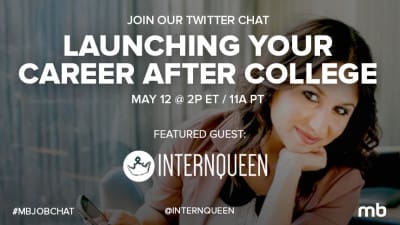Here is a bold (but true) statement for anybody out there seeking a new job. If you are looking for a job and you are still not active on LinkedIn, you are behind. As you read this article, you are literally missing out on opportunities by not having LinkedIn. Or, if you have a profile and it’s not updated, you might as well be in the former camp. You’re completely missing out.
There are over 100 million active users on LinkedIn every month. That’s roughly a third of the United States population. A huge chunk of those people are recruiters, managers and people you can leverage to get a new opportunity.
Also on Mediabistro


Fortunately, it’s fairly easy to make sure you have an all-star profile that will attract recruiters and hiring managers. Use the below tips to make sure you have a top notch profile and before you know it you will be on the phone with your next opportunity.
1. Think of LinkedIn as a search engine for recruiters
When you are writing your summary, your bullet points under each job and listing your skills, think of what terms recruiters in your industry will be searching for. It’s almost like SEO. You will show up higher, and you will be more relevant to them.
2. Focus on completeness
When your profile is simply complete, meaning it has a photo and has each section filled out, you are automatically putting yourself in a better place than people you’re competing against. To recruiters, you come off as somebody who cares, puts the extra effort in and realizes what’s important. Imagine you’re looking to buy a piece of furniture off Craigslist. Would you be more likely to purchase one with a clear image and detailed description, or would you gravitate towards one with no picture, no description and just a title?
3. Ask for recommendations from anyone you’ve done anything for
Recommendations are the same as reviews for a product or business. There is no better way to build trust than for a recruiter to read that you’ve been effective in the past. Make a list of 5-10 old colleagues, managers or former clients. Reach out to them and ask for a quick recommendation for your LinkedIn profile. Even if only 1 or 2 of them respond, that will be plenty.
4. Write a stand-out headline
At the top of your profile, write a headline that will catch the eye of a recruiter without being cheesy. For instance, if non-profit is your niche, instead of “Seeking a New Marketing Position,” try “Digital Marketing Expert for Non-Profits.” If you’re just getting started, rather than “Student at Some University” or “Business Management Graduate” go with something like “Financial Analyst seeking a new position” or “Digital Marketer seeking media roles.”
5. Write industry articles
LinkedIn Pulse allows anybody to be an author. Go the extra mile and write a few insightful articles about your industry. When a recruiter goes to a profile with quality content written about a particular subject, the candidate is seen as a subject matter expert and immediately has more potential to be contacted.
6. Have a clear and decent-quality photo
It doesn’t even need to be entirely professional or taken with an expensive camera. Any new-ish smartphone can take a clear enough photo that will suffice for your LinkedIn. Find an area with good lighting on either a solid color background or somewhere outside with a neutral background. Just make sure the photo is a headshot from the shoulders up so that your face is the primary focus. Wear a collar or something professional on your top half, and you are ready to go. No need to go crazy with it—just have a clear photo.
7. Link to your LinkedIn from your email signature
Having an email signature is just another subtle way to position yourself as a professional who cares. In most professional roles, you will have an email signature with your name, email, phone number and a few relevant links. Make one for your personal email as well. Include a link to your LinkedIn profile and make the link text say “Connect With Me on LinkedIn!” or something similar. This is another small step that could set you apart from other candidates who just end emails with Sincerely, Joe.
8. Add links to a personal website or portfolio
LinkedIn is the new resume. Fortunately, it’s way better than a traditional resume because not only does it list all of the same information as a resume, but it also allows you to include links to external sources as well. Take advantage of this and link to all relevant projects, websites and pages that describe what you’ve done in more detail.
9. Edit the default LinkedIn URL you’re provided
This is just a quick way to increase the “completeness” of your profile, and it’s also another touchpoint for a recruiter to remember your name. You can click “Edit” on your profile and change the random letters and numbers to your actual name or something else unique to you.
10. Join groups where your ideal targets will be
LinkedIn allows you to join Groups that cover just about any industry or topic. Once you’re accepted into the groups (yes, you must make a request to join), post some of the industry articles you’ve written, and be sure to include a call-to-action stating you’re seeking a position or would be interested in speaking to recruiters. Just don’t post too much, or make it too obvious and have people tune you out for being spammy.
11. Write a strong 3-5 sentence summary
At the beginning of your LinkedIn profile, take advantage of the ability to write a summary. Introduce yourself, give clear insights into where you are professionally and what you’re looking to do. Do not overdo it with buzzwords, don’t be vague about who you are or what you do, and don’t come off as too much of a salesperson. If it ends up being longer than a few sentences, break it up into multiple paragraphs. Remember, most people view your profile on mobile, and text can end up seeming very long even if it’s not.
12. Post at the right times
If you are looking for a job, and you’re actively posting articles, sharing updates or reposting interesting content, do it at the right times so people see it. Recruiters will likely be on LinkedIn in the early morning and during business hours. Other people might be on in the evenings after work. Just tailor your posts to the times your ideal audience will actually see them.
13. Leverage your existing connections
Occasionally, creeping on LinkedIn is fine. Use your connections to find some relevant 2nd and 3rd level connections in your industry. View their profile, and your name will pop up for them as “Viewed Your Profile”—and you will be on their radar. Combine that with a complete and efficient profile, and you will have people reaching out in no time.
LinkedIn is the most powerful tool in the world for developing new professional connections and unlocking opportunities that could change your life. It’s right there for the taking. Take advantage of the opportunity to make yourself shine.
Has LinkedIn helped you earn opportunities in the past? Do you have any other tips to add for those who may be new to the platform and are currently seeking jobs?










